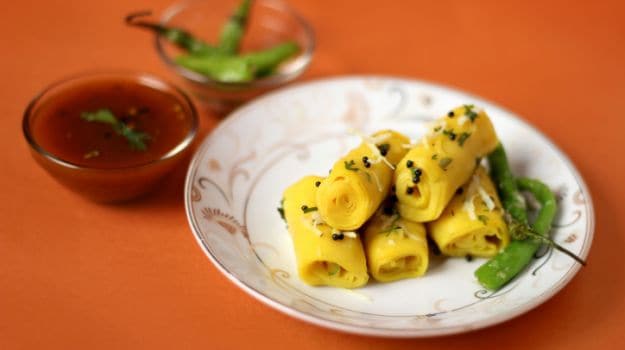What is Khandvi?
According to MasterChef contestant Siddharth Talwar, "Gujarat is one of my favourite places in India, the food and people are amazing. They have a special love for homemade snacks. In my opinion, Khandvi is our version of a rolled pasta made with gram flour. It has a very attractive vibrant yellow colour that it derives from the besan or gram flour, and is rolled tightly and then cut into bite-sized pieces."
Khandvi, also known as Patuli or Dahivadi is a steamed snack made with gram flour and buttermilk or yogurt and served with green chilies, grated coconut, coriander leaves, ginger and mustard seeds. The gram flour batter is cooked to make a thick paste and spread thinly on a flat surface. It is then rolled up tightly into small bite-sized pieces and steamed.
Points to Remember While Making Khandvi:
- Consistency of the batter is one of the most important aspects while making a Khandvi. Make sure it is properly cooked and not too thick. Khandvis are thinly shaped and taste best when given a correct shape. If the batter is too thick, batter won't spread properly on plate/thali.
- Once the batter is made, spread it on the plate/thali immediately. If the batter cools down, it won't get you the desired results as you spread it out. To see if your batter is ready to be rolled into Khandvi sheets, take one teaspoon of the batter and put it on an oil-greased thali or plate and spread it across the area to make it as thin as possible. Roll the batter over, if is rolling flawlessly, it is ready, and else you may have to cook it for another minute or so.
- Usually people use curd to make the batter; chef suggests using buttermilk, which will make khandvi moist and tastier.
A Desi Twist to Ravioli: Khandvi Ravioli
Celebrated Chef and Restaurateur Manish Mehrotra at his renowened restaurant - The Indian Accent, gives a desi twist to the Italian ravioli by using Khandvi sheets instead and adds goat cheese to it to create a fusion dish. His idea is to take regional Indian dishes and transform them into something unique that can be served on a global platter. This is how the famous Khandavi Ravioli evolved. Chef Manish had also tweeted a picture of his Ravioli Khandvi in the making and captioned it saying, "#Ravioli #factory @Indian_Accent....loads of #khandvi ravioli with arbi #cheese mash in #production.....#MakeInIndia." Take a look:
#Ravioli #factory @Indian_Accent....loads of #khandviravioli with arbi #cheese mash in #production.....#MakeInIndia pic.twitter.com/kBF8UFDTqI
- Chef Manish Mehrotra (@manishmehrotra) January 29, 2015
If you haven't tried making Khandvi at home before, here's a great recipe you can use:
Besan Khandvi
Recipe by Aadhar Restaurant, Ahmedabad
 Photo Credit: Instagram/twinks_cookbook
Photo Credit: Instagram/twinks_cookbookIngredients:
1 cup besan3 Tbsp curd
Salt, to taste
1 tsp turmeric
1 tsp red chili powder
Hing, a pinch
3 cups water
Oil to grease
For the tempering:
2 tsp oil1 tsp mustard seeds
2 tsp sesame seeds
2 chopped green chilies
2 Tbsp water
Coriander leaves, to garnish
Red chili powder, to garnish
Method
1. In a kadhai/ wok mix together besan, curd, salt, turmeric, hing, red chilli powder.2. Add 3 cups water gradually to make a batter.
3. Now turn on the heat (medium flame) and start stirring the batter continuously.
4. Once the batter reaches a thick consistency, turn off the heat.
5. Grease the back side of the plates with a little oil and spread the thickened batter. (Make sure the 6. batter applied is not too thick or the khandvis won't roll.)
6. Let them cool for 10 minutes. Cut strips with a knife and roll.For the Tempering:1. In a small pan add oil, mustard seeds, sesame seeds, chilies and water.
2. Pour over the khandvi. Garnish with coriander leaves and red chili powder and serve.





